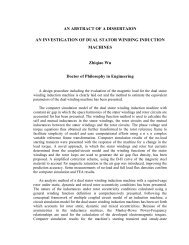CLIFFORD AND GRASSMANN HOPF ALGEBRAS VIA THE ...
CLIFFORD AND GRASSMANN HOPF ALGEBRAS VIA THE ...
CLIFFORD AND GRASSMANN HOPF ALGEBRAS VIA THE ...
Create successful ePaper yourself
Turn your PDF publications into a flip-book with our unique Google optimized e-Paper software.
4 Conclusions<br />
The present paper was intended to show how a CAS allows to ask questions<br />
of research interest and to come up with low dimensional solutions. During<br />
this process we have worked out examples showing how to use the BIGEBRA<br />
package and how to attack more advanced problems.<br />
We hope that it became obvious from our presentation of the <strong>CLIFFORD</strong> [3]<br />
and BIGEBRA packages that the ability to compute, via a CAS, allows to build<br />
a sound knowledge about mathematical problems and that there is a need for<br />
experimental mathematics in education and research.<br />
This article is, due to restrictions in space, obviously not able to give a complete<br />
review of all abilities of the <strong>CLIFFORD</strong> and BIGEBRA packages. Therefore<br />
the interested reader is invited to check the package home page 5 for the documentation.<br />
Both packages come with a built-in online help where, for every<br />
function, syntax, synopsis and examples, and sometimes a more advanced<br />
mathematical background is provided. A printable ps or pdf version of over<br />
500 pages is available there also. For those who wish to have a look at and<br />
a feel for the packages, there is a possibility to access them online over the<br />
web 6 .<br />
There are tremendously many open problems coming with a bi-convolution of<br />
mathematical and physical type. It is not yet clear, under which conditions<br />
antipodes exist in higher dimensions. In dimension 3 a Clifford bi-convolution<br />
has in general no antipode, hence further relations between scalar and coscalar<br />
product have to be found. Only very little is known about the nature of the<br />
crossings derived from antipodal bi-convolution, but see [10]. The axiomatics,<br />
in terms of morphims and category theory of Clifford bi-convolutions, is under<br />
consideration but not yet finished [17,19]. Clifford bi-convolutions are deeply<br />
connected to the renormalization process of the quantum filed theory. However,<br />
there one has to go beyond the scheme presented in this paper, see [4,5]. A<br />
CAS and especially <strong>CLIFFORD</strong> and BIGEBRA are ideally suited to explore this<br />
exciting field.<br />
Finally we want to emphasize that the present article contains Maple output<br />
(with only a minor TEX cosmetics) which was generated by processing a Maple<br />
worksheet.<br />
Acknowledgment: The second author, B.F., acknowledges gratefully financial<br />
support from University of Konstanz, LS Prof. Heinz Dehnen, to present<br />
5 url: http://math.tntech.edu/rafal/<br />
6 url: http://clifford.physik.uni-konstanz.de/~ fauser<br />
19
















